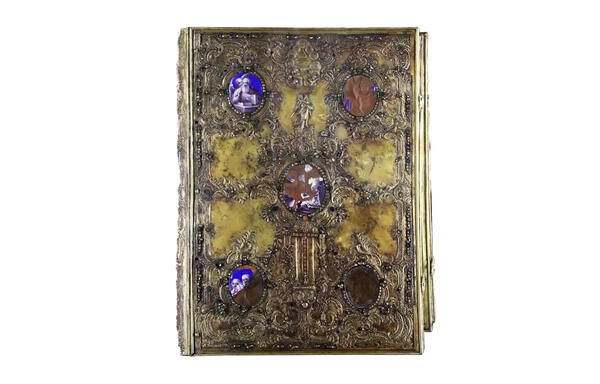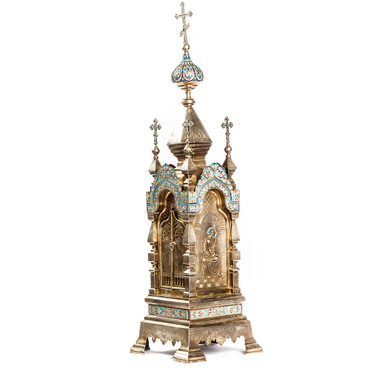The Gospel book for the liturgical use with a metal cover was manufactured in 1759 in the Moscow Synodal Printing House. It was printed on expensive and high-quality Alexandrian paper. The font of the publication imitated the uncial: before the advent of printing presses in Russia, that was the way church books had been copied. The text was decorated with drawings by Semyon Vtorov, engravings by Vasily Ikonnikov, frames on the margins, ornamental ligature, illumination, and decorative initial letters.
The cover for the binding was made of gilded silver and decorated with inserts of enamel, semi-precious stones, minting, engraving, and art casting. The weight of each Gospel from this circulation reached 30 kilograms, 20 of them was the weight of the book block itself. In total, from 1756 to 1759, about 600 such volumes were published in Moscow, 50 of them were designed to be given as a gift to the emperor, his family members, and other influential persons.
Since 1763, the Gospel remained in the Church of Intercession of the Most Holy Mother of God — the main church of the Zaporozhian Sich. It was handed over by the last ataman of the Zaporozhian Sich Peter Kalnishevsky. In 1775, the Sich was abolished, the sacristy and precious vessels from the Church of Intercession of the Most Holy Mother of God were moved first to the Cathedral of St. Sophia in Kyiv, and then to the Alexander Nevsky Monastery in St. Petersburg. From there, in 1798, some of the items, including the Gospel, were transferred to the Black Sea Cossack Army. According to one version, the book first went to the field Holy Trinity Church, then to the Host Resurrection Cathedral, and only then to the Alexander Nevsky Cathedral of Ekaterinodar (today — Krasnodar).
The word ‘Gospel’ in Greek means ‘good news’. In Christianity, this is the message about the coming of the Kingdom of God and the salvation of the human race. Bringing out and reading the Gospel are the most solemn moments in Orthodox worship. It is read during mattins, all-night vigil, Divine Liturgy, prayer services, and individual church sacraments. For this purpose, a special liturgical Gospel is used. In the Russian Orthodox tradition, it is always written in the Church Slavonic language, divided into chapters, verses and into separate thematic pericopes — parts of the text intended for reading on different days of the year.
The cover for the binding was made of gilded silver and decorated with inserts of enamel, semi-precious stones, minting, engraving, and art casting. The weight of each Gospel from this circulation reached 30 kilograms, 20 of them was the weight of the book block itself. In total, from 1756 to 1759, about 600 such volumes were published in Moscow, 50 of them were designed to be given as a gift to the emperor, his family members, and other influential persons.
Since 1763, the Gospel remained in the Church of Intercession of the Most Holy Mother of God — the main church of the Zaporozhian Sich. It was handed over by the last ataman of the Zaporozhian Sich Peter Kalnishevsky. In 1775, the Sich was abolished, the sacristy and precious vessels from the Church of Intercession of the Most Holy Mother of God were moved first to the Cathedral of St. Sophia in Kyiv, and then to the Alexander Nevsky Monastery in St. Petersburg. From there, in 1798, some of the items, including the Gospel, were transferred to the Black Sea Cossack Army. According to one version, the book first went to the field Holy Trinity Church, then to the Host Resurrection Cathedral, and only then to the Alexander Nevsky Cathedral of Ekaterinodar (today — Krasnodar).
The word ‘Gospel’ in Greek means ‘good news’. In Christianity, this is the message about the coming of the Kingdom of God and the salvation of the human race. Bringing out and reading the Gospel are the most solemn moments in Orthodox worship. It is read during mattins, all-night vigil, Divine Liturgy, prayer services, and individual church sacraments. For this purpose, a special liturgical Gospel is used. In the Russian Orthodox tradition, it is always written in the Church Slavonic language, divided into chapters, verses and into separate thematic pericopes — parts of the text intended for reading on different days of the year.



